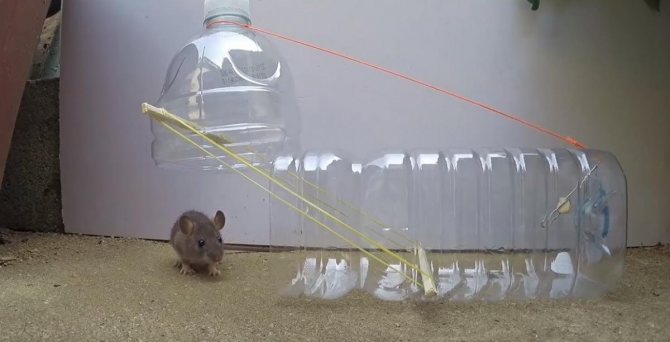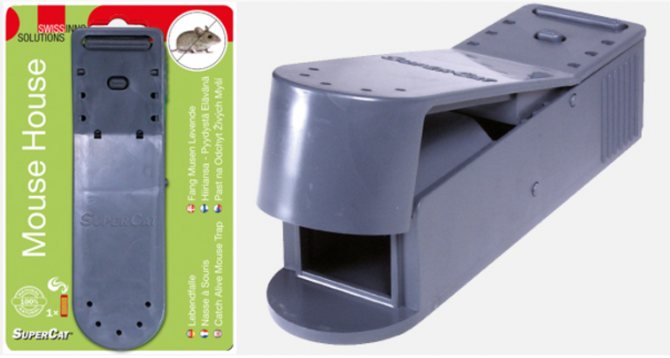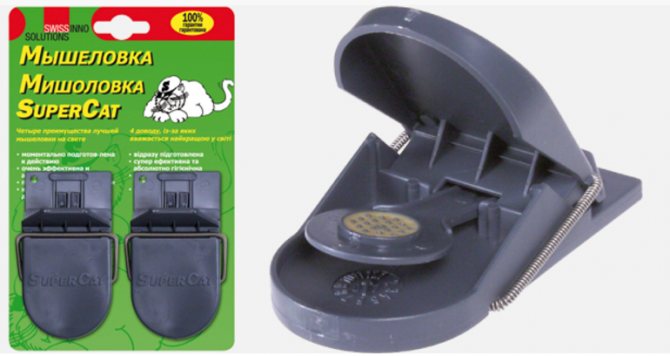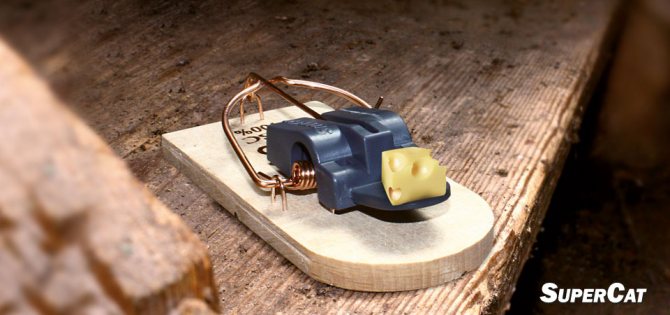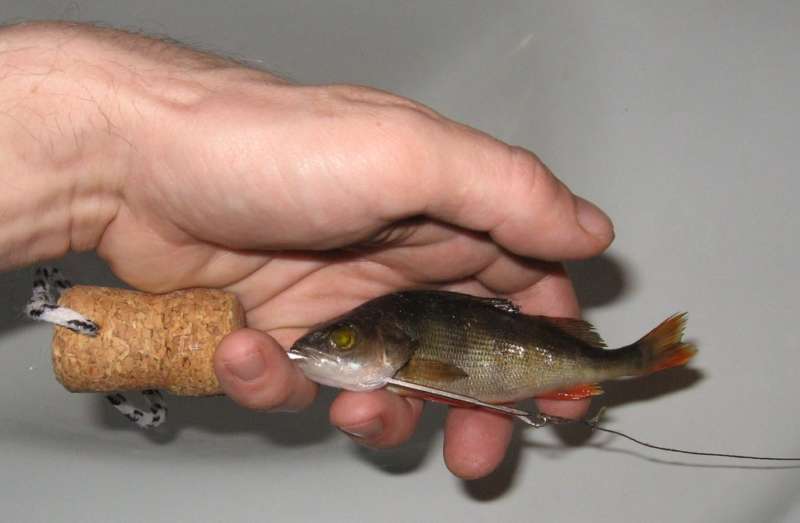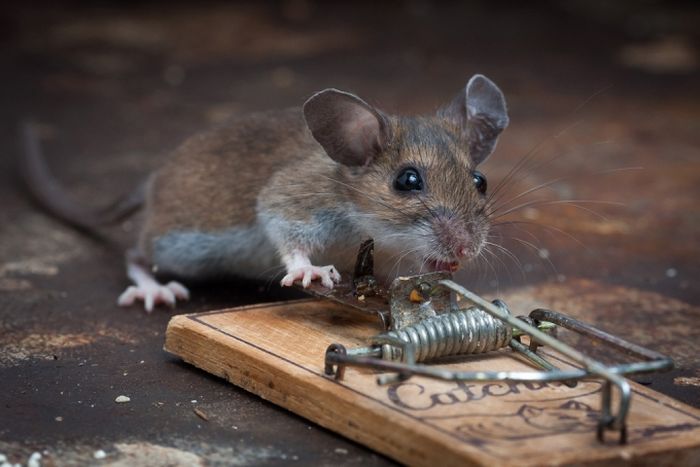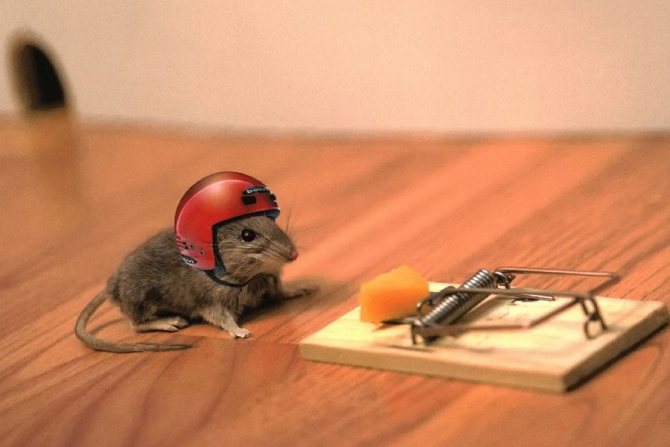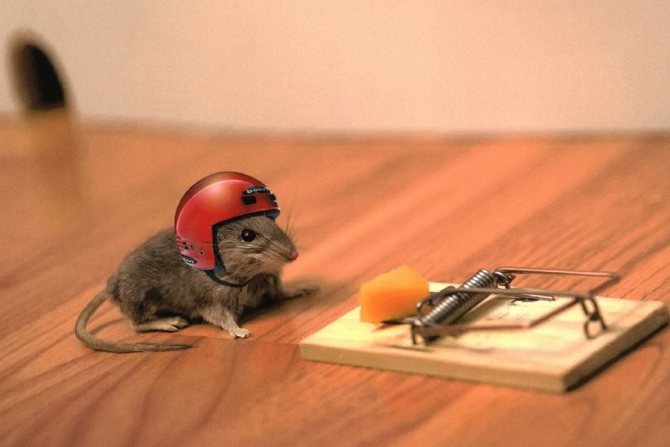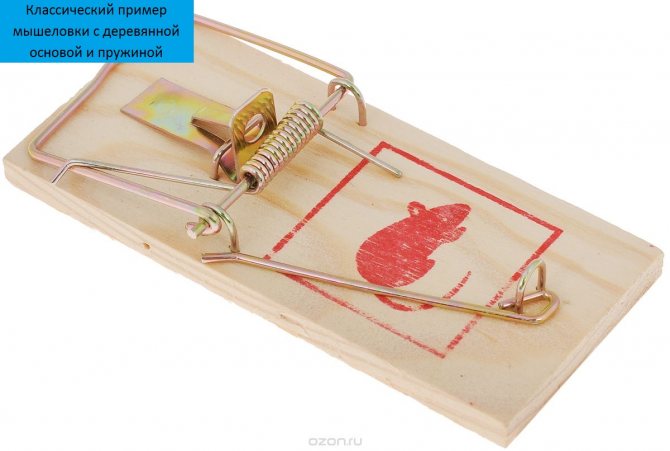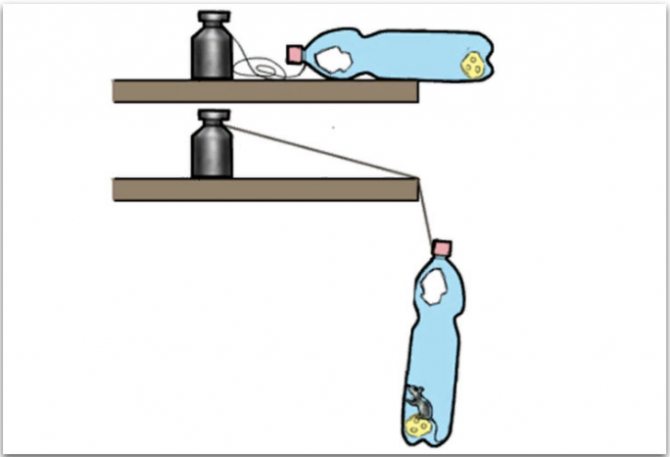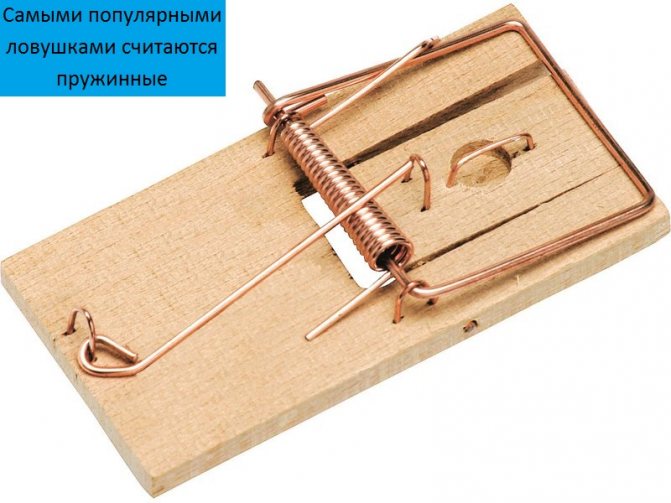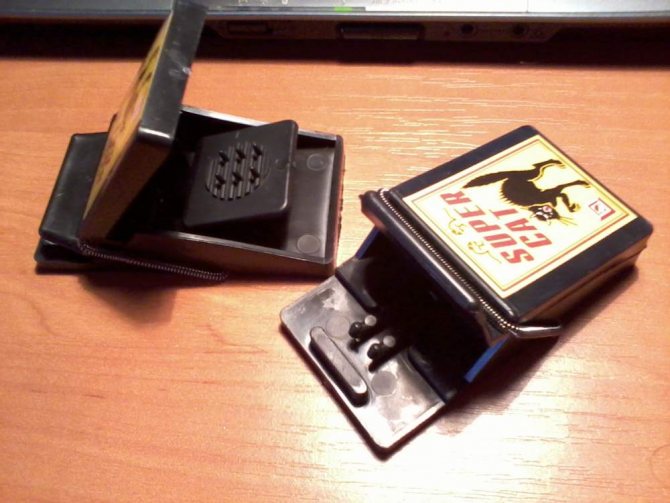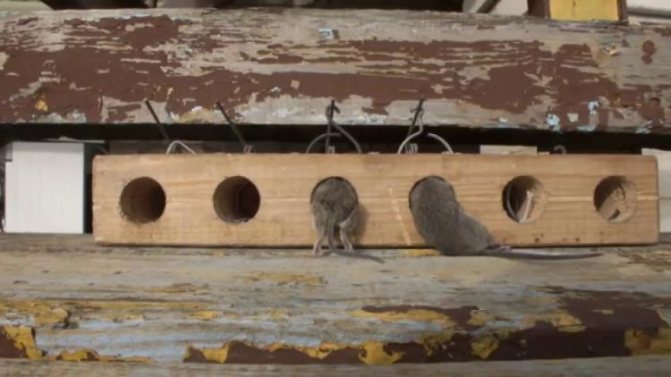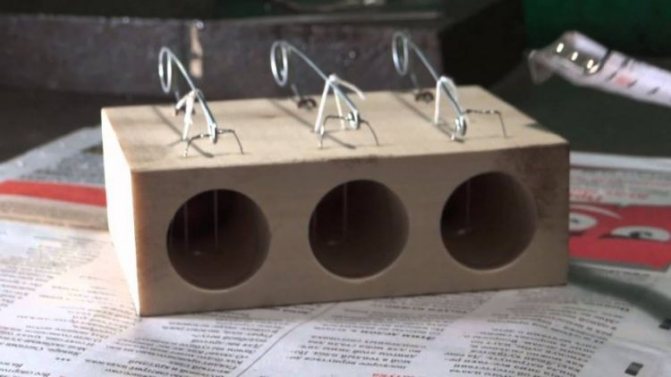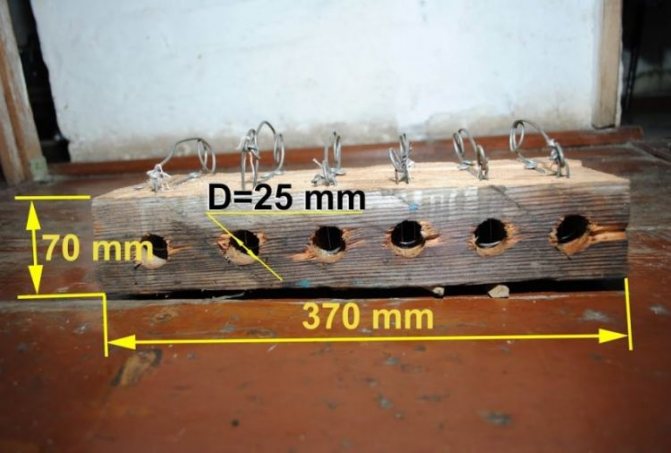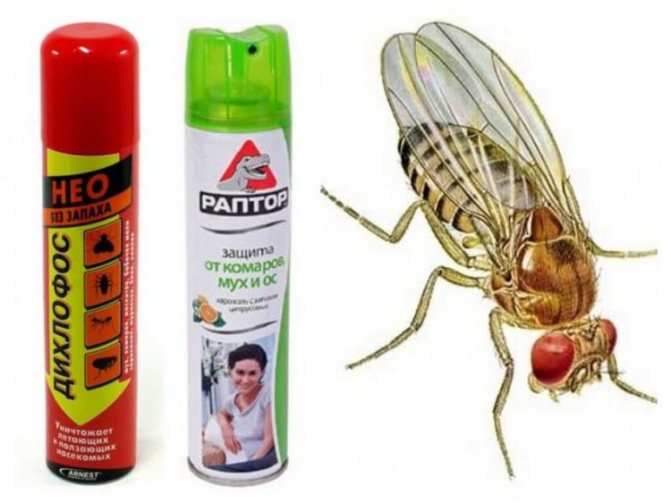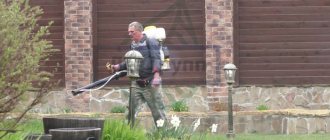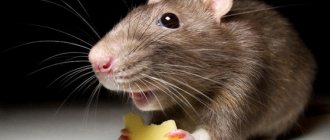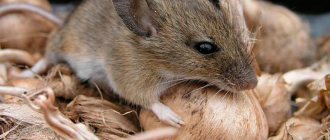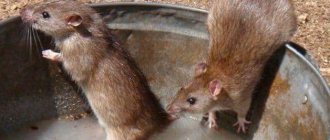The question of effective rodent control methods comes up from time to time for homeowners. The range of modern devices is great, but people often prefer mousetraps in the old fashioned way. Charging them is easy if you follow the instructions. You need to choose the right type of trap, bait and placement. The device can be purchased at a specialized store or made by hand.
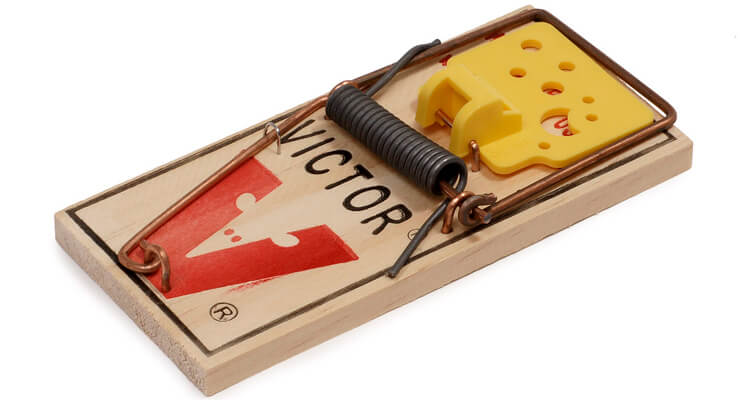
The mousetrap is effective only against a small concentration of small rodents.
TOP 7 best mouse trap baits
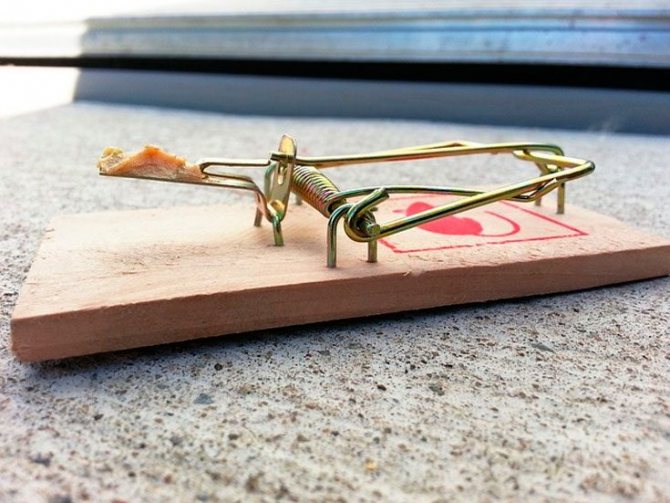

There are 7 types of foods that a rodent will not refuse. For example:
Salted or smoked bacon
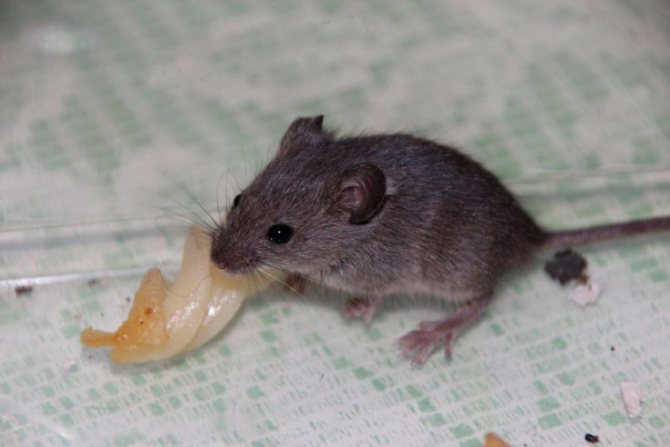

This type of bait has been tried by many generations of people. It is desirable that it be fresh lard, with a fragrant smell. Smoked bacon has similar characteristics. It is better not to use old bacon, which has a very specific aroma, as it is unlikely to interest mice.
Vegetable oil
Naturally, an unrefined product with a pleasant aroma is suitable for these purposes. It is enough to take a crust of bread and moisten it with vegetable oil, and then use it as directed.
Grain and baked goods
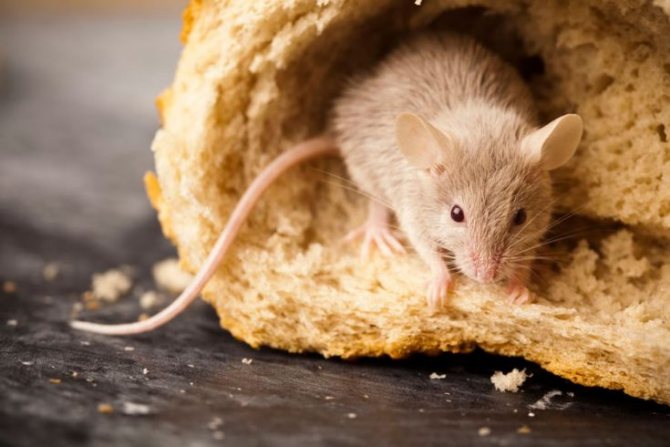

Fresh baked goods that include whole grains or bran are great for gray aggressors. Moistening a crust of bread with sunflower oil will attract pests like mice. The effect can be increased by treating cereals with rat poison.
Cold smoked fish
This product is like a magnet, attracts gray aggressors. Naturally, you need to take only a high-quality product. If you use rotten, unusable fish, then the side of the mice will bypass such a trap.
Sausage
It also attracts mice, since they contain enhancers of smell and taste. Despite the fact that sausages are literally stuffed with chemicals, they can serve as good bait. Of course, it is better to use homemade sausage, where there are no chemical components.
Cheese
It is believed that cheese is a favorite treat for mice and rats. Nobody can prove it or disprove it. But cheese, in any form, especially smoked cheese, can serve as an excellent bait. In any case, this myth can be refuted or proven.
Raw minced meat with onions
This method is more suitable for catching rats. Of course, a mouse is unlikely to refuse such a delicacy, so such a bait works flawlessly. You can add a little rat poison to the mixture of ground meat and onions, so as not to upset the balance of tastes. For 10 parts of minced meat, at least 2 parts of onion should be taken, but more should not be taken, so as not to upset the balance of aromas.
Traditional methods
Previously, people tried to fight predators from the forest on their own and used improvised means for this:
- The walls of the chicken coops were smeared with tar, it was believed that this smell should scare away small pests, such as ferrets. But if the animal comes from a tunnel under the ground, then the walls smeared with tar will not become an obstacle for him. In addition, not every ferret has an unpleasant smell of tar.
- It used to be thought that goat skin was suitable for scaring away ferrets. But this method can rather be attributed to preventive measures.If you hang the skin in an airtight room, then perhaps the effect of this will be.
How to catch a mouse
To trap a mouse in an apartment, you need to understand where and where the rodent appears.
- Unlike rats, mice search for food only at a distance of 10-25 meters from their habitat. Traps should be placed where mice are most likely to appear.
Mice prefer to travel along walls and other vertical structures. Mice are very inquisitive and will explore each new item placed on their feeding area.
If you can't catch the mouse right away, the device can be moved to another location, writes Michael F. Potter, a specialist at the University of Kentucky College of Agriculture.
Mice eat grains and seeds, nuts, butter, and sweets. Mice are nocturnal animals, and during the dark they are able to go out in search of food up to 30 times. They leave behind them a black oblong droppings 0.3-1.2 cm long, due to which their recent appearance is easily disavowed.
But before you start placing, it is better to first take the time to prevent rodents from appearing in unwanted places. Cracks and holes over a quarter of an inch wide should be repaired.
Weak points: holes for water pipes in the wall and a gap under the door. To make the room less attractive, you need to keep it clean: remove food debris.
After that, the basic measures, if necessary, can be supplemented with the placement of special agents for mice.
To check if mice are really in the house, you just need to pour a little flour in the "suspicious" areas where the animals are supposed to live, and see if traces appear the next morning.
Depending on personal preference, you can choose different ways of catching mice - from harmless to quite cruel. It should be borne in mind that these rodents rarely leave their nests during the day, so you need to set traps at night.
Interesting fact. Incisors in mice grow throughout their lives, so animals are forced to constantly grind them, gnawing everything. With the help of its teeth, the animal can destroy structures made of wood, concrete and even metal.
The mouse is dangerous to humans because it can cause a dangerous infection, especially if it gets to food
Murderous mousetrap
An old, tried and tested, but not always effective way to catch a mouse is to use a mousetrap. The latter can be industrially manufactured and vary in design. The principle of operation of such a device is to lure a rodent and then kill it or inflict injury through a special mechanism.
Little cute animals only look harmless and fragile, but in fact, having mice in the house means a lot of trouble.
How to catch a mouse in an apartment?
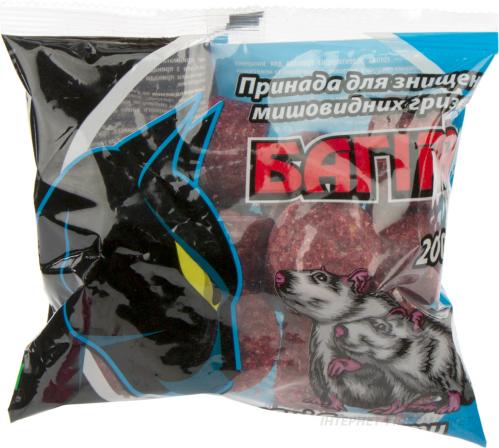

In some cases, you still have to be interested in the answer to a similar question.
Purity is the enemy of the rodent
Observing cleanliness in the house and following the recommendations, you can create conditions that will become unbearable for the life of mice and they quickly retreat home.
- Periodic spring cleaning will help to avoid the accumulation of debris, food leftovers in corners, drawers and other inaccessible places, and therefore, rodents will not have the opportunity to profit from anything.
- Products are stored in tightly sealed jars or metal containers with a heavy lid.
- Household and kitchen waste is collected in buckets with lids and taken out of the apartment in a timely manner.
- Install the grilles on the ventilation ducts, close up the holes in the floor and baseboards.
Where to put mousetraps
If there are a lot of people at home during the day, it is better to put mousetraps at night. Rats and mice do not like to leave their burrows during the day.You can find out that they were in the apartment by the excrement they leave in their places of stay. Rodents do not like open spaces, so they move along the walls. There you need to place the mousetraps.
To get into the apartment, they make holes with a diameter of 4 cm or use any holes, even the size of a coin. Go through the kitchen, carefully examine all the walls, dark corners. If you find a mink, place the mousetrap next to it. Sometimes rodents run after household appliances and furniture. Place traps near burrows or along a wall, 60 to 90 cm apart. You can put one under the oven, in the pan section.
Self-installation instructions
To ensure that the rat falls into the trap, the mousetrap is installed in the places where the animals live most often.
The mechanism should be properly adjusted. This step is especially important for traditional spring traps.
After capturing the animal, the rat should be pulled out in such a way as not to injure the fingers.
Seat selection
It is advisable to install the device in places where rodent colonies congregate.
Use the following guidelines to determine the location of their home:
- traces on the floor of the apartment, which remain from the rubbing wool of the pest;
- paths from the feet on the floor;
- animal excrement;
- squeak or rubbing of paws (to hear, create absolute silence).
Attention! If you see one dead rat, be prepared to find their colony around.
Examine the floor and walls carefully for cracks and holes. Rodents can hide in them.


Favorite localizations of rats and mice:
- under the closet;
- behind furniture;
- in the upper part of the basement;
- between desk drawers or boxes.
If you find a pest habitat, place the mousetrap as close to it as possible.
Installing the gatehouse
The main step is to properly adjust the trap mechanism and charge it without damaging your own fingers.
Make a needle threader (it can be supplied ready-made in the kit), fix it in a spring, press the last to the body and load the bait - this is how to set the "classic" mousetrap correctly.
To make the needle threader yourself, take a wire like a guitar or balalaika string with a length of 20 to 25 cm. Bend it in half.
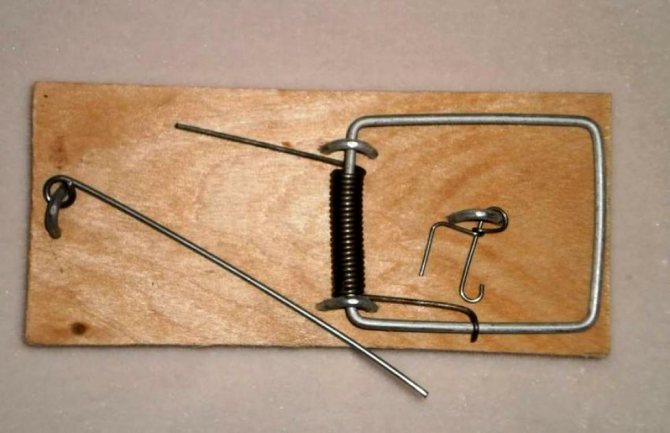

Step-by-step instructions for installing the gatehouse:
- Turn the trap with the holes towards you.
- Thread the line from top to bottom, right to left.
- When the threader has entered the rat trap body, insert the thread there.
- Pull the line up.
- Pass the wire in the opposite direction (from bottom to top, from the left hole to the right).
- Pass the thread over the spring.
- Insert into the threader and pull downwards.
- Turn the bottom of the rat trap towards you.
- Collect the spring to the device and tighten the thread.
After you have started the mechanism, you should refuel the rodent bait.
Location
In homes where children and pets live, open-type mousetraps should be abandoned. Loop traps will also not work. Choose humane cage traps that do not kill the animal.
Place the device in the area between the rodent's nest and food.
Better to put 3-4 mousetraps. Rats are more active at night, so it will not be possible to recharge the mechanism in time.
It is advisable to choose an area protected from moisture. This will prevent damage to the mechanism and bait.
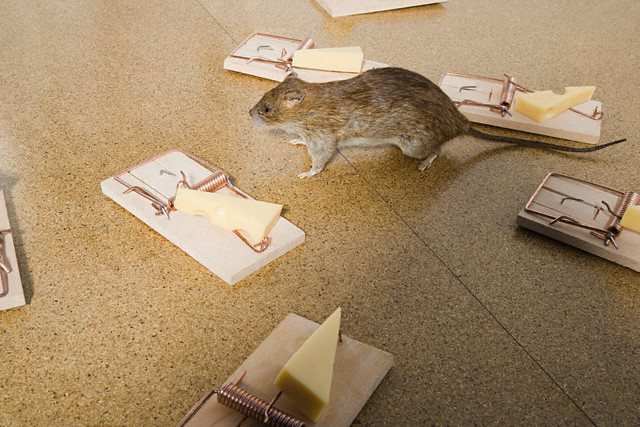

Traps are also installed in non-residential areas: in the basement, shed, garage, bushes.
Recycling
When the device is no longer needed, it is disposed of as household waste. The rat trap can be thrown into a general landfill or burned.
Important! Do not rush to get rid of the mousetrap when all the rodents are destroyed. The service life of the device can be up to 40 years.
Installation rules and site selection
Often, the owners think about the intricacies of placing a mousetrap, because a colony of rodents can reach the scale of a disaster. Pests spoil wiring, food, and also transmit infections. The process is simple, if you follow the step-by-step instructions, how load a mousetrap depending on its type:
- With a spring. You need to put the bait on the hook by pulling the spring.
- Traps. Food must be put in portions.
- Electronic systems are turned on according to the instructions attached to the device on how to supply a mousetrap from the manufacturer.
Traps
Any device for catching a ferret should be set at night, this is important, given the nocturnal lifestyle of this predator. The traps must be arranged so that the bird cannot fall into them even when panic begins in the barn from the appearance of an uninvited guest.
Before loading the trap, it should be treated with a special compound that will destroy the repelling human odor. It can be slaked lime and even ordinary manure. If a burrow has already been clearly dug, then a trap is placed right next to the exit from it.
The trap should be sensitive and bait should be put there. It could be the blood of a bird. Ferrets can also be caught with the help of a strong rat trap, it is able to keep the predator. In order to add additional weight to the trap, it must be fixed on a large board. It is better not to put small rat traps: the ferret will turn them over and easily free itself, and later it will be easy to bypass such traps.
Murderous methods of getting rid of mice
One of the most brutal ways to catch a mouse is to set up a mousetrap. You can buy it in a specialized store. Following the instructions, set up the mousetrap and install it in the place where the intruder is most likely to appear.
Use a strong-smelling product as bait:
- Animal feed.
- Smoked sausage.
- Peanut butter.
- Tainted meat.
After the mouse falls into the trap, take it out and throw it away, or better yet, bury it so that it does not appear to you later in a dream.
Types of mousetraps
Mousetraps come in a variety of styles, from traditional spring traps to electric ones. It is necessary to install mousetraps in those places where, in your opinion, the rodent lives:
- In the closet.
- In a drawer.
- In the pantry.
- etc.
One mousetrap may not be enough to capture rodents, and using several devices, you can catch several mice at a time. Since mice are carriers of many dangerous diseases, check the mousetrap regularly and discard the corpse, but use protective gloves and even a protective mask to protect yourself from contact with dangerous bacteria.
You can kill mice in another way, adding poison to the food, but as a result, if the mouse returns to its hole and dies there, then the unpleasant smell of a decomposing corpse will spread throughout the apartment.
Advice:
- If you decide to buy a mousetrap, then remember that electric mousetraps are much more effective than mechanical ones.
- Close the mouse holes only if you are sure that you have got rid of all the mice, otherwise they will gnaw new holes or die behind the wall from dehydration, which is also unpleasant.
- As soon as you find uninvited guests, act quickly, as mice can bring friends or proliferate quickly.
- Place poisoned baits out of the reach of pets and children.
Where and how to install
It is recommended to put the mousetrap in the place where rodents most often live, for example, in the kitchen. This must be done with rubber gloves so that the smell of a person does not scare off mice.
Read also: Tulips crocuses hyacinths daffodils


You can install in the following areas:
- In the space under the furniture.
- Hollow walls, if any.
- If there are storage rooms, a basement, a cellar or other premises that are intended for storing food, the installation should be done there.
- You can also place mousetraps on the shelves of cabinets that are needed to store food supplies.
In the absence of specific areas, you can position the mousetrap where it will not pose a danger to pets and children. Sooner or later, rodents, attracted by the scent of the bait, will fall into the trap.
Other ways to control rodents
The methods listed above are not the only methods describing how to trap mice in your home.
We must not forget about natural born mouse hunters - cats.
Moreover, it is not at all necessary that it be a pied cat. Basically, the cat smell itself already scares off mice.
Let us draw your attention to such a method of struggle as. ... We do not recommend using it in an apartment.
The fact is that the poisoned mouse will begin to decompose gradually, and this unpleasant smell will be present in the premises for a long time.
We do not recommend using it in an apartment. The fact is that the poisoned mouse will begin to decompose gradually, and this unpleasant smell will be present in the premises for a long time.
You can also make homemade mouse traps to save the lives of these rodents.
Thus, the methods of dealing with mice in the apartment are quite diverse.
The choice of a particular one is made by everyone independently, because some methods are relatively humane, while others do not leave the mice any chance.
Ferrets' lifestyle
Ferrets are naturally active, curious, and have an excellent memory. The latter quality just contributes to the fact that the predator will come from time to time to the same chicken coop, where he once successfully got food. Hunting for a ferret is not particularly difficult, since nature has in it an excellent ability to swim, climb trees, run quickly and dig the ground.
At the same time, ferrets are very aggressive in the wild. They have their enemies. For example, they are afraid of foxes, wolves, large snakes and large birds (owls, golden eagles). Due to their agility, ferrets are most likely to avoid pursuit, and they also have a secret weapon. This is a special liquid that they spray when they are severely frightened. Ferrets have special glands under their tail that produce this foul-smelling liquid. Any opponent will be scared away by this substance.


How to charge
Before you set the trap in the chosen place, you need to properly prepare it for fishing. Various devices are presented on the market today. It is recommended to choose a disposable spring trap or a spring-loaded, reusable trap. In the last case, you will have to independently pull out the corpse each time and reload it again.
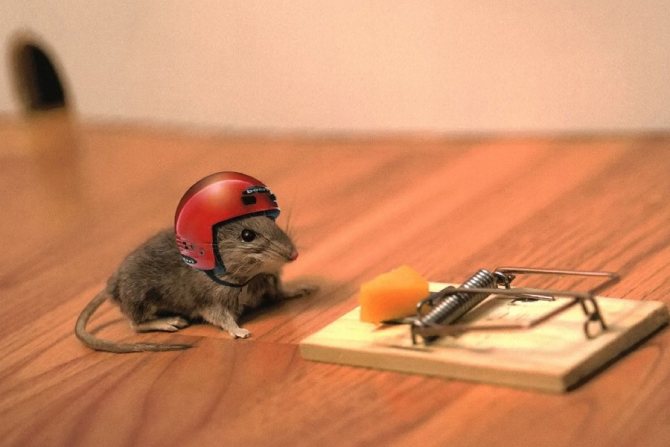

There are inexpensive wooden disposable mouse pads that can be purchased in a set of 3 - 5 pieces. They will come in handy if there are already a lot of rodents in the house and there is a need to install many devices at the same time. The main mistake during installation is putting too much stock for the trigger. The bait should be placed so that the spring would work even when you lightly touch the food, and not at the moment when the animal will finish eating it.
The bait is put on the trigger, after which the clamp is carefully cocked. You will need to put a holder on it
And the holder itself is inserted into the trigger mechanism. Another description of the installation of the spring device - the pin must be directed in the direction opposite to the spring, pull the metal bracket back towards the pin, press the bracket down with one hand, and put the pin on it with the other.
Further, it must be placed in a hole in the metal plate on the other side. To allow the bracket to be held in place. It remains only to raise the plate and release the trigger mechanism.
Lure selection
The key to successful rodent fishing is choosing the right bait. It is widely believed that mice love cheese and, if possible, eat this product exclusively. In fact, rodents prefer cereals, meat products, sweets.
To catch annoying rodents, it is recommended that you choose the following foods as bait:
- Bread that smells delicious with any vegetable oil. To prepare this mouse delicacy, you need to soak the pieces in oil in advance. It is also widely believed that rodents love peanut butter. You can check this by putting some product on white bread.
- Sausage, boiled meat, regardless of the variety, lard.
- You can also trap sweets such as pieces of muffin, rolls, muffins, or even chocolate candy.
Periodically you need to inspect the mousetrap. If the bait is left intact, the chances are high that the rodents have access to food sources that they find particularly attractive.
To whet the interest of the mouse clan in the bait, you need to replace the old one with fresh food. Also, you need to replace it after catching each rodent.
When using mousetraps, the main safety rules cannot be ignored.
Preventive measures
Mice appear in human dwellings for a number of reasons. Often, the owners are to blame for this themselves, not paying due attention to the technical condition of the house or apartment, although mice can appear through open doors. The presence of cracks and holes makes it easy for any rodent to enter the home, but here it is warm and there is always something to profit from. Therefore, such owners always complain about the presence of rodents, which do not allow them to sleep at night.
To understand the cause of this problem, you will have to pass the test, which is described at the beginning of the article. If, as a result of the answers to the questions, it was possible to score a certain number of points, which indicates an affirmative answer "Yes", then it is necessary to immediately correct the situation. It is necessary to strive to ensure that there are no positive answers at all, then you will not have to meet with rodents. Of course, it will not be possible to fulfill all the conditions, but those that depend exclusively on the owners are quite real.
Naturally, it is better to take care in advance so that rodents do not enter the dwelling. There is not much to do for this. It is enough to check the apartment or house for factors that allow rodents to enter the premises. If such conditions exist, then they need to be eliminated. You may have to do some cosmetic repairs to the apartment to get rid of holes and crevices. At the same time, you need to take care that food is stored so that mice do not get to them. You should not stock up on bulk food for the long term, clogging pantries with them. As a rule, little remains of such products.
If it so happened that the rodents entered the dwelling, then one should not hesitate to get rid of them. It is enough to make a simple trap and use a fragrant bait and the problem can be solved. The sooner this happens, the better, until the rodents manage to build a nest and begin to breed, then it is much more difficult to deal with them.
When and what methods of bait baiting should be used?
It is important to understand that the method and variant of bait baiting depends largely on the individual reservoir and the time of year, as noted above for the example of the current. But at the same time, general factors can also be distinguished:
The pike is characterized by an inactive attack of live bait. So, she very often bites him precisely from the side of the tail. That's why the most optimal way to attach the trap is to the gills. Because when eating live bait, the trap will definitely work, as a result, the pike will have practically no chance to escape. This is the most suitable option for an active predator bite. This method will be most productive when fishing at night.
But it is important to understand that this method is not suitable for all live animals, because some of them simply cannot survive it or, as mentioned earlier, will behave unnaturally. Crucian carp and gorchak are the most popular live baits. Try to do as little harm as possible when placing the bait.
However, in stagnant water, bait bait is preferable for the ridge.
Zürner's mousetrap how to make at home
A similar design to the previous design - a Zürner trap at the base with a box, which is masked from the outside with a sloping lid, inside with galvanized iron. Two opposite sides have inlet openings or windows, opposite each of them there is a bridge on a hinge, the ends of which rest on the edges of the openings. The inner ends, without supports, form a long bridge stretched “over the abyss”. A hook with a bait is attached above the zone of closing of the bridges, fixing it on the lid of the box.
The design works according to the following principle:
- the mouse runs across the bridge to the bait;
- under its mass, the bridge bends and the animal falls to the bottom;
- the bridge returns to its original position.
Is it possible to make a trap at home with such a device? This is possible, and the process of constructing a structure will be many times simpler than the process of constructing the previous mousetrap "top"
How to charge
What is the best mousetrap and how to charge it before using it? You can choose any trap. But work carefully, use gloves. Rats and mice have a sensitive nose. If the mousetrap itself or the bait smells like a person, they will not fit.
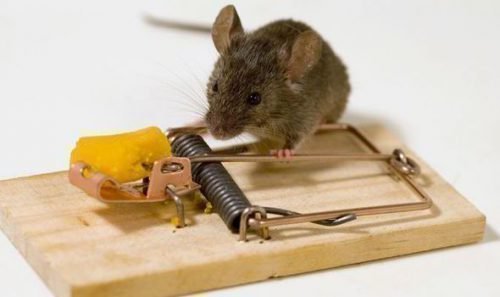

If the mousetrap smells like a person, the mouse will not fit it.
Mechanical mousetrap
This is an uncomplicated design that is inexpensive and is sold at any hardware store. It can be made of metal, which is suitable for catching rats. most reliable. Mice are caught with wooden ones. To catch rodents, it needs to be charged. It will be difficult to do this the first time, so be careful, as she hits her fingers painfully.
This mousetrap consists of:
- Trigger (1).
- Clamps (2).
- Retainer (3).
To charge the mousetrap, take the bait and put it on the trigger (it must be attached securely, otherwise the mouse will drag it away and run away). Then we take the clamp and gently cock it. You need to put the retainer on it and insert it into the trigger so that the retainer slides off from the slightest touch. Now it remains only to place it where there are many rats and mice.
How does a mousetrap work? The rodent touches the bait and hits the trigger. At this moment, the retainer slides off and releases the clamp. It slams shut and presses the mouse. If the mousetrap is not secured, and a large rat gets caught in it, it can drag it away with it.


Mousetrap design: the mouse pulls the trigger and the trap slams
Other types of mousetraps
- Live trap for mice. It's even easier to charge it. The bait is placed in a special hole, the structure itself is placed on a level place. As soon as the mouse falls into the trap, the trap is slammed shut. It does not kill a rodent, but catches it, you can then release the mouse away from home.
- Electric mousetraps. They are powered by an electrical network. It is opened and laid along the baseboard. The bait is put inside. The mouse runs inside and receives a powerful electrical discharge that kills it. Before that, the mousetrap slams.
- Cages, containers. The bait is put into a special device. This device helps to catch live mice or rats.
All these types do not need to be charged, it is enough to put the bait in a specially designated place.
Security measures
To prevent injury while fishing, take into account the precautions to ensure the fishing process is safe:
- For winter fishing, you should take special gloves that will help you work with the device and with the bait.
- Take your time while working with the trap. The hook must be held precisely at the base of the spring, with the sharp end away from you.
- Don't forget about the pliers. They will be required if the trap is falsely triggered.
- It is also important to take a first aid kit with you, the need for which may arise unexpectedly.
Fishing for pike is fun and exciting, but be careful not to spoil your fishing trip with injuries and wounds.
Very important: in many regions of the Russian Federation (and in other countries, for example, Belarus), this type of fishing is legally prohibited. Because they are considered poaching gear, their use carries responsibility. That is why, if you want to use them in fishing, then be sure to check the legislation of the region where you plan to fish, so as not to break the law!
In conclusion, I would like to note that the pike trap is a well-known device. The method of baiting the live bait depends on the particular reservoir taken and the preferences of the angler. Do not forget about safety rules, and before fishing, check if pike trapping is allowed in your region!
Homemade mouse mix
Composing a diet for a small animal entirely depends on what mice eat in nature. Since this is a detachment of rodents, then they will mainly feed on plant food:
- cereals such as wheat, barley, rye, some oats, etc .;
- plant seeds and nuts, for example, sunflowers, walnuts, peanuts, hazelnuts, but there should not be too many of them: excess vegetable protein will lead to obesity and liver problems;
- vegetables and fruits - which ones to give will depend on what the mice love the most, but you need to offer all sorts: carrots, zucchini, cucumbers, pumpkins, apples, bananas;
- green parts of plants: parsley, dill, sprouted grains - they contain a lot of carotene and vitamin C.
Black bread, dried fruits (raisins, prunes) are used as delicacies. It is also worth answering a fairly common question: do mice eat cheese? They eat it with great pleasure, but in large quantities a dairy product provokes liver problems, leading to obesity.
If cheese is given, it is very, very rare and in small portions.
General characteristics of the predator
Ferrets are mammals of the mustelidae family. Ferrets have an elongated body, they are particularly flexible and agile. These animals perfectly climb the tallest trees, dig deep holes. Males are somewhat larger than females.
Habitats are very different, it depends on the type of animal. Ferrets often move closer to a person's home. On the territory of Russia, two types of ferrets are usually found - steppe white and forest black. Under favorable conditions, ferrets are sedentary in some of their territory. And only hunger can push them to a human habitation, where there is always food for them.
The basis of the diet of any ferret is food of animal origin. They hunt and eat birds, rodents, insects, reptiles and even venomous snakes. A ferret will never miss a nest with eggs. He will drink them all and destroy the nest. Large individuals can become a real threat even to hares and muskrats.
Due to their agility and endurance, ferrets can pursue their prey for a long time. But, as a rule, they prefer to watch for prey near its own burrow. The peak of the hunt is at night, but if the night hunt is unsuccessful, the ferret will do it during the day. Ferrets are not attracted to plant foods.
Features of the choice of bait
An important point in pest control is the right bait.No matter how effective and expensive the trap is, you cannot attract a mouse without tasty food. There is an opinion that mice are crazy about cheese, but in fact, very different foods are among the rodents' delicacies.
Lures that will impress any mouse:
- fried bread in vegetable sunflower oil;
- fragrant pastries and other flour products;
- pumpkin and sunflower seeds;
- salted or smoked bacon, a slightly charred product is also suitable;
- peanut;
- smoked sausage.
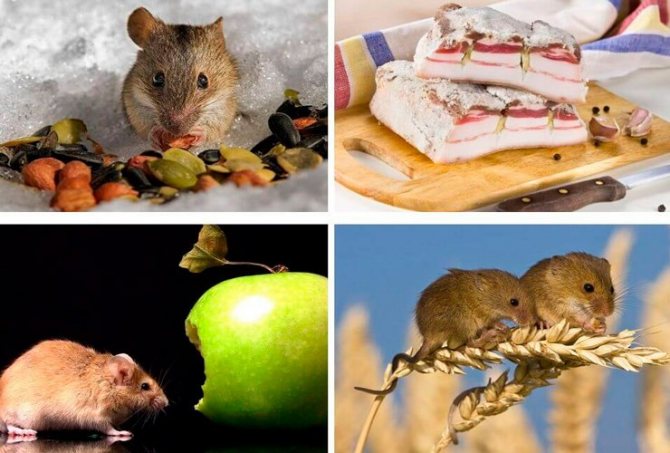

For traps that do not have a trigger, it is recommended to use commercially available baits. They are made from common foods and odorous additives. The strong scent will lure mice.
Ferret habits
In order to more successfully fight the enemy, it is necessary to study his habits. Ferrets in this case are no exception, a person must know the characteristics of this predator for a more effective fight against it. In particular, there are two unusual behaviors:
- The ferret will steadfastly defend its territory, and it does not matter at all which enemy invaded it. Having lost its territory, the ferret can quickly say goodbye to life, since it will have nowhere to hunt and hide.
- Ferrets are naturally weak hearts. It so happens that a predator trapped in a trap dies from an excessive release of adrenaline into the blood - his heart simply cannot cope with such a load.
What are the advantages of mousetraps from scrap materials
Before considering the features of the top mousetraps, a few comments on their advantages over ready-made traps or such fancy devices as an electronic mousetrap for exterminating rodents.
If you compare the traps made at home, with the drugs used to bait rodents, the former will be more humane and safer. You can catch uninvited guests with homemade boxes, buckets and bottles at any time, without requiring the removal of household members from the house. But insecticides for the presence of children and pets in the house are not provided, which creates certain difficulties.
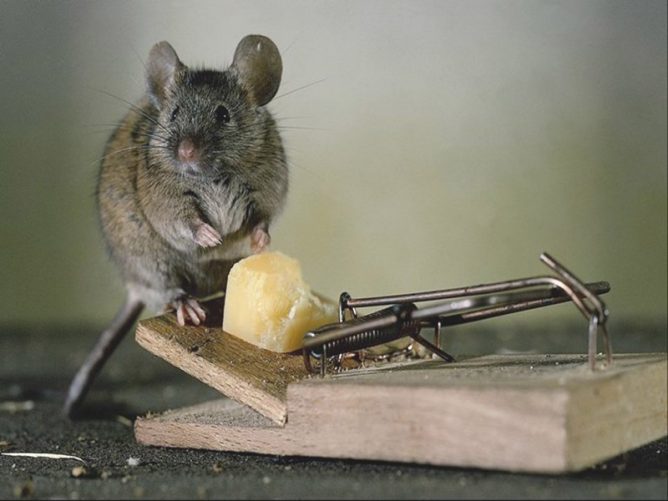

The indisputable advantage of a homemade rodent trap is the availability of funds. You can make a mouse trap out of anything at no extra cost, from a cardboard cake box to a plastic bottle.
An important advantage of hand-made mousetraps is their reusability. In addition, most traps work in such a way that they do not require constant monitoring.
Precautions
The main thing when installing a mousetrap is not to damage yourself. This is especially true for spring devices, where the mechanism can suddenly slam shut.
Basic Precautions:
- Do not put your fingers under the raised frame.
- Do not set traps where children and pets can reach.
To prevent the mechanism from rusting, periodically lubricate it with oil.
The mousetrap is an effective method of getting rid of rodents. The most modern and convenient are electronic traps. They quickly kill the animal without annoying squeak and blood. If you feel sorry for a rodent, use a cage or swing. After catching the mouse, release it further away from the house.
Home mousetraps
It is not necessary to purchase the trap in the store - you can assemble this device at home. Such devices work no worse than purchased ones. With their help, knowing how to charge a mousetrap, you can get rid of pests in the country and at home. For such a device, you need things that can be found in any household.
To set a trap at home, you need to take a bucket three-quarters filled with water. So that the mouse dies quickly, soap should be added here. Then put the bucket in a place where animals are congregating. In order for the rodents to climb to the bucket, a ramp (board, panel) should be installed. Floating food is lowered into the water. Mice attracted by the scent will fall into the bucket and drown.
You can get rid of pest rodents using a large variety of trap models. With the help of any of them, you can protect housing from a rodent.
It is very important to start killing mice in time, as they are carriers of dangerous diseases. For example, it could be a hantavirus that spreads through urine and droppings.
Rodents, in addition, are carriers of bedbugs and ticks, which can infect humans with Lyme disease.
For the initial stage, it is better to use homemade traps, since it will not be difficult to charge a homemade mousetrap, as well as to make it. Such a device is no less effective than expensive store devices. But such a simple design can save money that could be spent on the purchase of proprietary funds.
Actual
Miscellaneous Miscellaneous
Using a mousetrap to trap rodents is one of the simplest, yet most effective ways to control pests.
The fact is that the use of mousetraps helps to get rid of the biggest drawback of using modern means - the death of mice in hard-to-reach places, which is often accompanied by the release of a pungent and poisonous odor.
However, in order to effectively use this simple device, you need to know the principle of the mousetrap and the place where it needs to be placed.
Pros and cons of homemade devices
When rodents start at home, it is not necessary to immediately buy poisons, which are very toxic to humans and animals. The simplest and safest solution in all respects will be a mousetrap.
The classic version can be purchased at a hardware store. Only he has one significant drawback - if there are a lot of mice, you will have to spend a lot. The mechanism is simple, but its operation is one-off. After each capture, you have to recharge the device. The conclusion follows from this: it will not work to leave a few mousetraps in the country and leave with the hope that upon their return the rodents will be exterminated.
As practice has shown, most homemade traps, in addition to being reusable, have a number of other advantages:
- Contains no poison. Most of the chemicals used in rodent baiting are toxic and can make humans or pets feel unwell. Mousetraps made from improvised means do not contain hazardous substances, since they operate mainly mechanically.
- There is no need to leave the premises. Professional rodent exterminators also use poisonous substances. For some time after treatment, it is better not to appear indoors, as there is a risk of getting intoxicated. Mousetraps are completely safe in this regard.
- There is no threat of unsanitary conditions. The captured mouse will die on the spot and the remains will be easy to dispose of. Being poisoned, it will most likely perish in its hole, from where it will be impossible to get it. The body, decomposing, will begin to spread an unpleasant odor and attract scavengers.
- Saving. Homemade designs save the family budget from unnecessary spending on purchased mechanisms. They are made from simple things that can be found in every home.
Advice: when there is a threat of a large invasion of mice, and not two or three hangers, it is better to give preference to reusable traps. With them, you don't have to make new ones all the time and install them around the house.
The disadvantages include the fact that a person who is not used to creating various mechanisms and structures needs practice. Its first complex traps will be ineffective and, most likely, inoperative. Better to start simple and remember that each model has advantages and disadvantages.
Varieties of traps
The instructions for using a mousetrap depend on its design, as well as the place where the war has to be fought.
- The plastic bottle trap can be used in the vegetable garden, garden, cellar. The operating manual does not contain specific rules. It is enough to dig it into the ground, or fix it under a slope near the steps, shelves. When a mouse falls into a homemade mousetrap, it stays inside, cannot get out because of the slippery walls, which are pre-lubricated with vegetable oil.
- It is not necessary to place a trap from a bucket of water under the wall; it can be made in the middle of the room. In order for the mouse to fall into the mousetrap, you need to use a fragrant bait, try to remove other food supplies from the house or room. Grass, leaves, straw, husks are placed on top of the water. Add a little vegetable oil, sprinkle grain, seeds. A stick is substituted for the bucket, it will act as a ladder.
- A mechanical trap is convenient in that it kills a rodent immediately or fatally injures it. How to load a mousetrap, there is an instruction. Install in the chosen place, fix the bait. Move the pin away from the spring. Bend the bracket, fix it.
On a note!
When using a mechanical or construction location, it must be changed periodically. Otherwise, the mice will master the new trajectory, they will not come across.
The sticky trap is especially popular. A special substance is applied to a dense base - cardboard, a piece of plastic, oilcloth, plywood. Fixed on a hard surface. possesses instant fixation, does not dry out within 1-2 weeks from the moment of application. The substance is applied in a continuous line with an interval between stripes of 2 cm. A 10 * 20 cm mousetrap is sufficient to trap mice. The trap is placed in those places where rodents have been seen. It is desirable near the burrow, nest.
On a note!
The glue mousetrap is used to control rodents in the garden. The bark of trees is cultivated to a height of up to 50 cm from the surface of the earth. The trap protects against rodents, harmful insects.
If the mouse does not come across, a mistake has been made somewhere. Instructions for using mousetraps:
- Rodents love twilight, but run to places where light falls. You can install a mousetrap. Direct a flashlight with a dim light at it.
- To catch mice, you need. Small rodents love cheese, seeds, grain, cereals, bread, cookies. Sausage, meat, bacon are eaten, but without much enthusiasm. This bait is more suitable for rats.
- You need to check the mousetrap often. The captured killed animal scares away the rest, the mice will begin to explore other territory. A live mouse in a trap will warn others about the danger with a restless squeak.
If there are many mice in the room, you need to alternate several different methods of struggle. A large army of rodents can be dealt with.
Features of installing different types of mousetraps
The installation method depends on the type of device.
The main types of mousetraps:
- spring;
- trap;
- electronic;
- "Humane" that does not kill;
- glue.
It will not be difficult to make a mousetrap at home.
Spring
The base of the frame spring mousetraps is made of wood or metal. A frame is attached to the top, into which a spring is inserted. It is fixed with a rod, at the end of which there is a hook. Pieces of food are placed on it as bait.
When the rodent takes the bait, the frame is released and swats the animal. The mousetrap can be reused. Each time it must be installed anew.
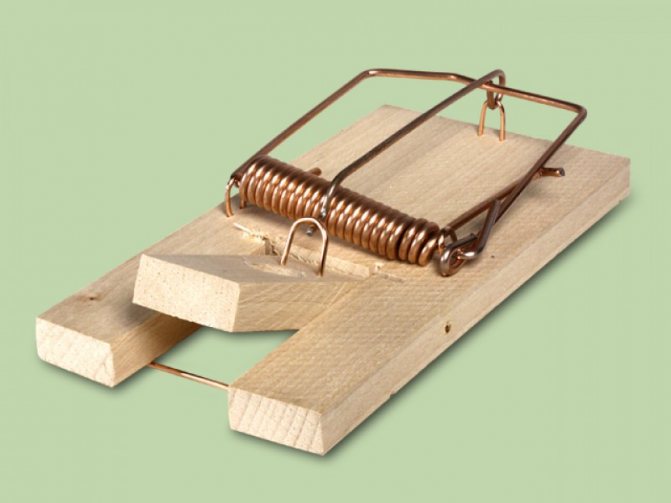

Here's how to install a spring-type rat trap:
- Place food on the hook.
- Cock the metal frame back until it stops.
- Without stopping to hold the frame, turn the rod with one hand and hook it onto the hook.
- Lower the frame.
For the device to work well, the hook must be at the tip of the shaft. A hard bait is suitable for a spring trap. The rat has to twist around a little on the hook to trigger the mechanism.
Traps
Traps, or clothespin mousetraps, are similar to bear-catching devices. They are distinguished by their smaller size and horizontal arrangement. The rat trap is made of plastic, has semicircular edges with teeth at the end.
Press down on the clip at the back of the trap, place the bait in and release the clip - here's how to properly use a clothespin mousetrap.
There are devices of this type for mice and rats. The latter are larger.
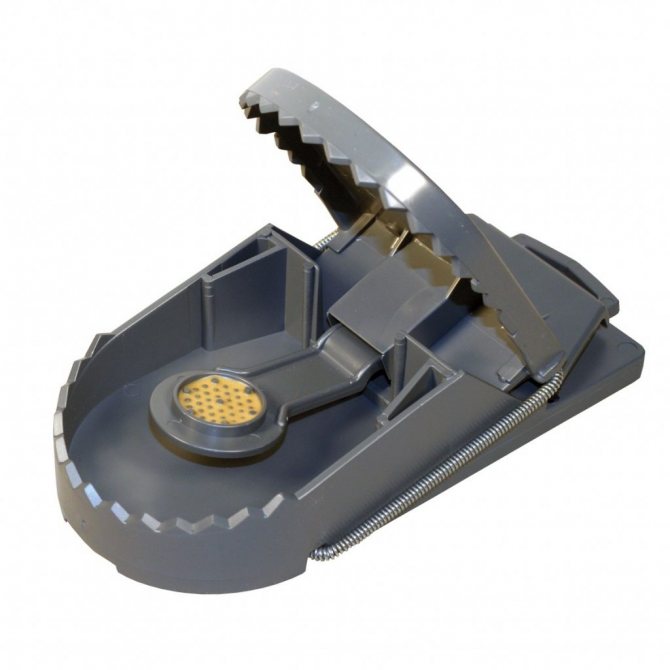

Electronic models
Modern electric mousetraps are the most convenient means of rodent control. All that is required of a person is to put the bait and plug the cord into an outlet. A second after being ingested, the rat dies from the electric shock. If mechanical models may not work, electronic rat traps are always effective.
Outside the case, there are LEDs that are set to move. They light up when a rat gets inside.
Traps That Don't Kill
If you are not satisfied with rodent-killing mousetraps, choose a more "humane" option:
- cells;
- swing;
- clothespins.
The cage looks like a mesh box with a spring-secured metal door. There is a hook inside. One end with a bait, the other fixes the door. How it works: as soon as the mouse grabs the bait, the door slams.
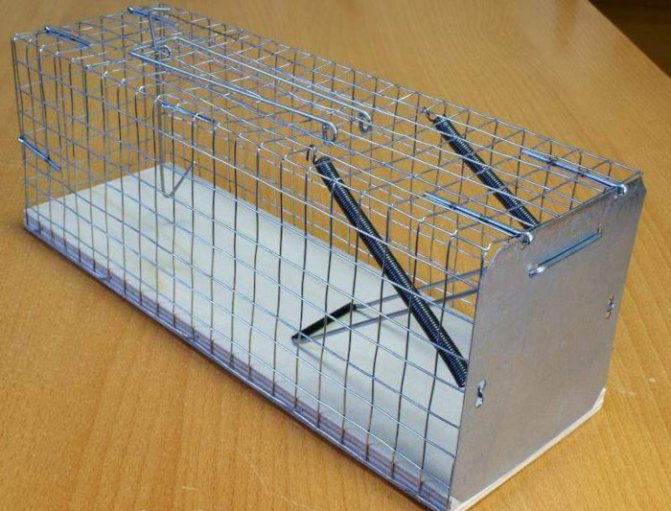

The swing-type rat trap is a long tube bent in the center. There is a door at one end of the device. The pipe is installed so that the part from the door fits snugly to the floor. The principle of operation is invented as follows: a rodent runs into a pipe, outweighs it. The door, which was previously open, slams shut.
There are clothespin mousetraps that do not kill animals. They are more elongated than classic traps. The bait is placed deep into the device. The flaps catch the mouse when it is completely inside. Therefore, the rodent is not damaged.
Glue
The device has a simple design. It is a single board covered with an adhesive that is resistant to moisture and sunlight. A bait is placed in the middle of the board. The rodent runs up to the bait and sticks firmly.
The glue is not poisonous and does not kill a rodent. Therefore, after catching a pest, you should decide how to get rid of it. You have to either kill or tear away from the trap, which is not easy. This is the main disadvantage of glue mousetraps.
The glue traps are for mice. You shouldn't rely on them when catching a large rat.
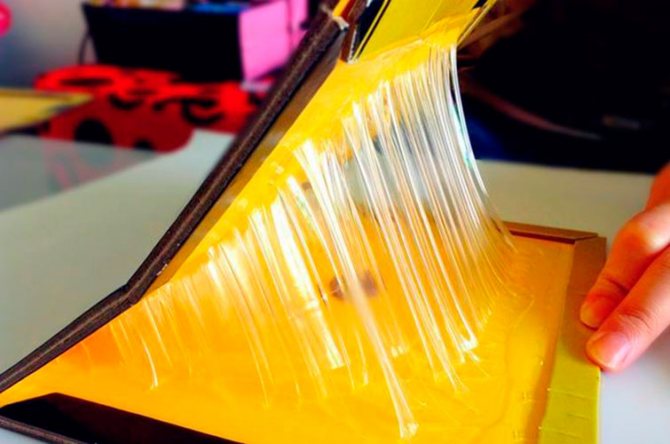

Homemade
Making a trap at home is not difficult. A bucket, straw, bait and a plank or ladder for a rodent will come to your aid.
Steps for creating a homemade mousetrap:
- Fill a container (bucket or large bottle) with water.
- Top with straw.
- Pour in some vegetable oil for scent.
- Put the bait. It should be light so as not to fall under the water. Grains or seeds will do.
- Lean a ladder for a rodent next to it.
To destroy rats in the basement, use an iron barrel. Throw in a bright-smelling bait. The rat will smell the smell, will run into the barrel, but will not be able to get out because of the edges of the container concave inward.
